During the summer of 1967 the Angeles Oaks Post Office in the San Bernardino National Forest served nearly 70,000 campers. With more than two dozen camps sponsored by the Boy Scouts, the Y. M.C. A., churches and other groups, the mountains northeast of Los Angeles had the largest concentration of summer camps in the United States. During the previous forty years the camps’ post office addresses had changed but the camps mostly remained in the same places. Three of these camps, Yallani, Wasewagan and Nawakwa, belonged to the Camp Fire Girls. [1] All three camps had long histories but they were not the first, or the only camps attended by the region’s Camp Fire Girls.
In the 1920s Camp Fire Girls camped at the Y. W. C. A.’s Camp Estelle in San Antonio Canyon and at Camp Torqua on Catalina Island as well as the Los Aneles municipal camp, Camp Seeley. Some camps such as Mawahua (1926), Ah-Da Hi (1927) and Talahe (1929) are mentioned in only one edition of Porter Sargent’s Handbook of Summer Camps, but by 1930 five permanent – or semi-permanent – camps, Hemohme, Yallani, Temescal, Wasewagan and Nawakwa, had been established for Los Angeles area Camp Fire Girls. [2]
Temescal in the Pacific Palisades and Yallani three miles above Seven Oaks may have been the first of these camps. A picture of two Camp Fire Girls “preparing to roast a couple of joints before an open fire” at Camp Temescal appeared in the Los Angeles Times in 1927. When Camp Temescal was selected for a leaders’ training course in 1940 the San Bernardino County Sun reported that it consisted “of a lodge, craft cabins and sleeping tents, and offers both the ocean and the foothills for recreation and training.” [3] It is not clear if the Camp Fire council ever owned the camp; apparently they stopped using it in the early 1940s.
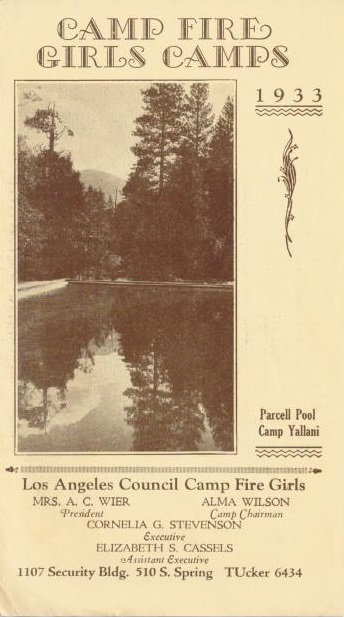
Yallani means “mountain” so the name distinguished this camp from Temescal. In 1933 girls could choose from four one-week sessions at Camp Yallani or from two one-week sessions at Griffith Park. At this time, before sleeping bags were commonly purchased, the list of “What to Bring” included four heavy blankets as well as sheets, a pillow and a hot water bottle. The Griffith Park girls’ camp was also an option for Los Angeles Camp Fire Girls in 1933 and 1934. Here they slept in cabins. Except for blankets which Griffith Park provided, the clothing and equipment lists were the same. As at most Camp Fire Girls’ camps at this time, girls were expected to wear bloomers and middies; shorts, overalls and daytime pajamas were not permitted. Griffith Park campers had to be six or older. Girls going to Yallani had to be ten or older. During the summer of 1948 over 500 Los Angeles Camp Fire Girls attended Yallani and in the 1950s a second camp, Yallani-Laheta, five miles from Yallani, accommodated 320 more girls for four one-week sessions. [4]
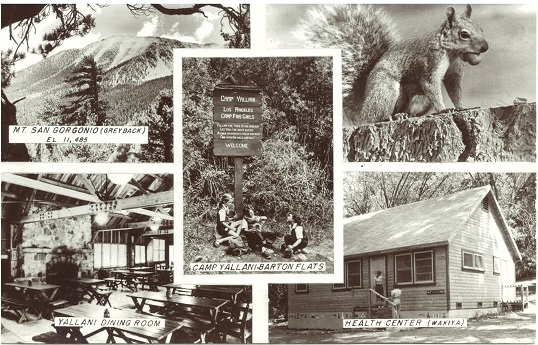
The demographic and social changes of the 1970s and 1980s meant that fewer children were in elementary school and fewer children attended summer camps. Camp Fire accepted boys in the mid-1970s and Yallani introduced Mother-Daughter camps and family camps but attendance declined. In 1985 the Los Angeles Area Camp Fire Council offered only two eight-day sessions and one five-day session at Yallani, compared to four two-week and ten one-week sessions (probably running concurrently) in 1966. Sometime after 1985 Camp Fire sold their permit for Camp Yallani to the First Missionary Baptist Church in Bellflower which renamed the camp Metoche.[5] Camp Yallani and the Pasadena area camp, Camp Wasewagan, also established in the 1920s, were located near each other on the Santa Ana River, among pine and cedar trees. At Yallani tents were available for sleeping if it rained but girls preferred sleeping outdoors under the stars.
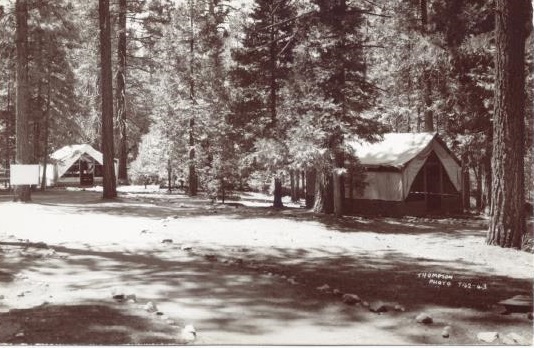
Camp Wasewagan’s official founding date is 1936. However it is listed in the 1930 Handbook of Summer Camps and newspapers report that in July 1931, 1933 and 1934 groups of San Marino Camp Fire Girls enjoyed weeks at “Camp Wasewagan Camp Fire Girls’ summer camp in the San Bernardino mountains. . .” According to the San Marino Tribune, “Camp Wasewagan is between San Gorgonio and Sugarloaf mountains in the San Bernardino range. It lies in the beautiful Santa River canyon near Seven Oaks and Camp Radford.” Evidently Camp Wasewagan moved from a rented camp to land purchased by the Pasadena Camp Fire Girls’ council in 1936. Purchase of the new four-acre camp, less than half-a-mile from the first Wasewagan was partly made possible with $500 from the fall doughnut sale. The camp, which already had a lodge, was below Barton Flats on the Redlands Road to Big Bear. [6] Wasewagan was still a Camp Fire Camp in 2001 but by 2005 it had been sold and was advertised as a private camp connected to the Lazy “J” Ranch Camp.
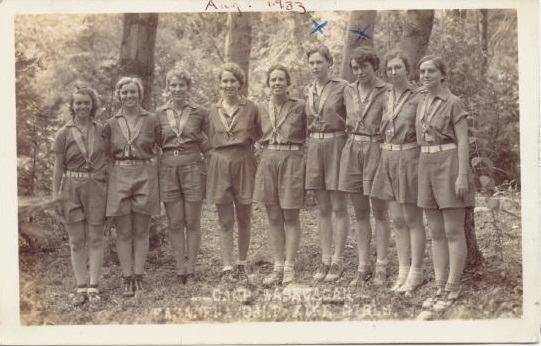
Another early camp was Hemohme, established by the Long Beach Camp Fire Girls around 1926. Hemohme was first located near Swartout. Guardians’ Training Courses were held here in 1930 and again in 1936. The 1936 “Summer Training Course Announcement” published in the April 1936 Guardian located Hemohme in “Mescal Canyon on the north slope of the San Gabriel mountains.” According to the announcement there were two mountain creeks providing water, the Mohave Desert was only two and a half miles north and three miles south was a mountain ridge. Pines oaks and cedars shaded the camp. Eldora DeMots, who had started her Camp Fire career at Kern County Union High School only 150 miles away a decade earlier, and Edith Kempthorne, Camp Fire’s national field secretary, directed the course. [7]
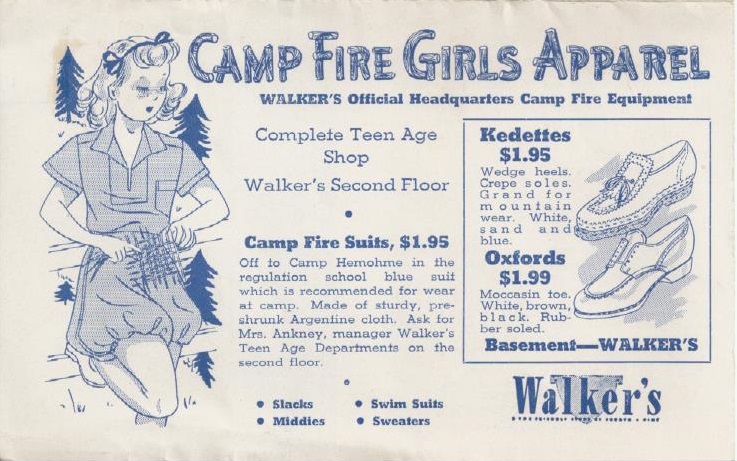
In 1938 the first Hemohme began “washing away.” A new Hemohme was established near Jackson Lake at an elevation over 6,000 feet, east of Wrightwood and Big Pines. This camp with “lodge and shower house complete enough to use” opened in 1945. The cost for seven days was $15.00. The Long Beach Independent reported that the camp had been acquired “through a citywide drive, donations from citizens, business firms and organizations.” Long Beach Camp Fire Girls enjoyed Hemohme until 1957 when the council opened Camp Wintaka on the Virginia Reid Moore Camp Fire Girls Reservation near Running Spring, about seventy miles southeast of Jackson Lake.
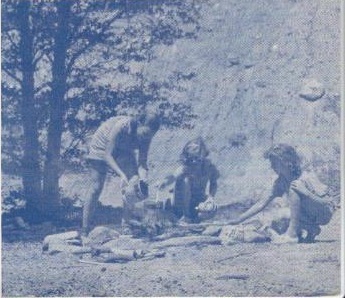
Hemohme was sold to a church and is now known as the Wrightwood Camp and Conference Center. Camp Wintaka opened with seventeen tents and a 50,000 gallon water storage tank. There was space for fifty girls the first year and Camp Fire Girls in sixth grade or older from other councils were invited to share the camp; the following year a lodge and shower facilities were added and the camp could accommodate a hundred girls. Wintaka means “the happy camp on the mountain.” Camp Fire Girls and Boys still enjoy Wintaka although the council offers only one week of resident camp. The rest of the year the camp is rented to other groups. [8]
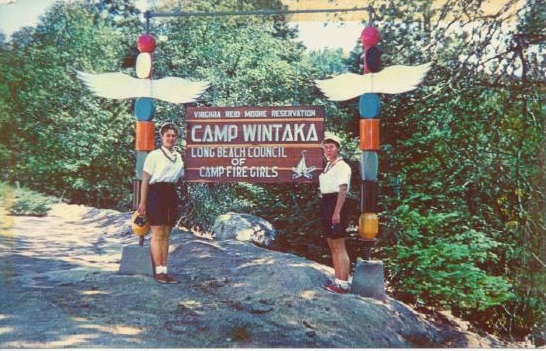
Camp Nawakwa, near Big Bear Lake, is mentioned as early as 1931 when Corona Camp Fire Girls camped there. Pomona Camp Fire Girls rented space at Camp Yallani from 1929 until 1935 and then held Nawakwa, which means “deep in the heart of the forest”, at the Boy Scouts’ Tulakes Camp. When that site was no longer available the Pomona Valley Council raised $20,000 and purchased a site in the Barton Flats camping area near Jenks Lake. In 1959 the council which then included the east San Gabriel Valley and the west end of San Bernardino County changed its name to the Mt. San Antonio Council. By 1961 the original Nawakwa site was no longer big enough so in 1963 the Mt. San Antonio Council purchased an adjoining camp, LiTanda, from the Compton Camp Fire council, increasing Nawakwa by ten acres. Camp Fire continued operating Camp Nawakwa into the twenty-first century. However, although the web page for the Inland Camp Fire Council has a link to Camp Nawakwa, it now seems to be a private camp. [9]
For about twenty years, from 1940 until 1961 the San Bernardino Camp Fire Girls sponsored Camp Acremolo in Waterman Canyon. In 1961 the council, with help from the Zonta Club, a service group for women executives, was able to purchase a former Girl Scout camp, Deer Ridge, in the San Gabriel Mountains. Ten years later both day camp and resident amp were being held at Deer Ridge. The camp apparently closed or was sold some time after 1973. [10]
Camp Metaka, at Jackson Lake near Big Pines, was a Y. M. C. A. camp in the 1940s. However, from 1958 until at least 1971 it served as the Rio Hondo Camp Fire Council’s camp and girls from San Bernardino who had already been to Acremolo could register to go to Metaka. In 1975 it was being advertised for group and family camping. Camp Cohila at Big Bear was dedicated by the Burbank Council of Camp Fire Girls in 1958. The name came from the first two letters of three words in “COmpanions among HIlls and Lakes” In 1979 Camp Cohila was sold to the Beverly Pines Development Company which planned to build houses. However due to the water moratorium of the early 1980s they defaulted on their loan and the camp was returned to Camp Fire. In 1992 Camp Fire put it on the market again. [11]

In 1965 Camp Fire guardians in Arcadia were told that five different resident camps were available to Camp Fire Girls from the Lost Angeles area, Cohila at Big Bear Lake, Metaka at Wrightwood, Nawakwa and Wasewagan at Barton Flats and Wintaka at Running Springs. Yallani should also have been mentioned.[12] A year later, in the summer of 1966 I was a counselor for five weeks at Camp Yenis Hante. At the end of the fourth week we faced a final week with only twenty-four campers. Since the council could not afford to pay a staff of fourteen, six counselors were let go. Camp Fire staff members had called other camps in California trying to find positions for these six counselors but all the camps had similar stories. It was the beginning of the decline in camp enrollments that echoed changing demographics and social change. The next decades saw closed schools and closed camps. Many of the camps are gone forever.
[1] Valley News September 4, 1967.
[2] Porter Sargent, A Handbook of Summer Camps Boston Massachusetts, 1930, 187-188.
[3] Los Angeles Times June 27, 1927;. San Bernardino County Sun Jul 6, 1940.
[4] At least two other camps, on in Oregon and one in northern California, have used the name “Yallani.”. Los Angeles Times June 22, 1958; June 1, 1958.
[5] Los Angeles Times June 20, 1976; April 4, 1978; May 23, 1985; American Camping Association Directory of Accredited Camps for Boys and Girls, Martinsville, Indiana, 1966, 29; YouthWorker Journal https://www.youthworker.com/articles/camp-metoche/ accessed February 24, 2019. .
[6] The San Marino Tribune (and the San Marino News) July 24, 1931; July 14, 1933; July 27, 1934; June 21, 1935; San Marino Tribune April 10, 1936.
[7] Long Beach Independent June 29, 1941; Oakland Tribune July 5, 1936; The Guardian “National Summer Training Courses” April 1930, 7; “Summer training Course Announcement” April 1936 .
[8] Camp Fire https://campfirelb.org/index.php/about-us/our-history accessed February 19, 2019; Long Bach Independent June 16, 1946; Press Telegram January 27, 1959. ; Pat Krig and Barbara Van Houten Wrightwood and Big Pines Arcadia Publishing, 2004, 106 https://books.google.com/books?id=RKMRY8BdVEoC&pg=PA106&lpg=PA106&dq=%22Camp+Hemohme%22&source=bl&ots=WhKvOQrTLk&sig=ACfU3U0Hfgf-6JvlxSunQIL0PdudEwnzXw&hl=en&sa=X&ved=2ahUKEwiAqvWEpLfgAhXNHjQIHZdKCv0Q6AEwCnoECAgQAQ#v=onepage&q=%22Camp%20Hemohme%22&f=false
[9] “Nawakwa” has been a popular camp name across the United States. Camp Fire Girls have used the name in Michigan and Illinois. There is a church camp named Nawakwa in Pennsylvania and there are Boy Scout and Girl Scout camps that have also been called Nawakwa as well as other Camp Fire Girls’ camps; Corona Daily Independent May 26, 1931; Chino Champion April 23, 1948; August 9, 2003; Betty Stolte “History of Camp Fire USA Mt. San Antonio Council” 2001; Los Angeles Times April 28, 1963; April 28, 1963
[10] San Bernardino County Sun June 4, 1940; March 6, 1960; June 9, 1961; June 26, 1961; July 30, 1961; August 6, 1961.
[11] Los Angeles Times June 18, 1944; August 18, 1957; August 1, 1971; San Bernardino County Sun May 24, 1958; September 16, 1975; Pat Krig and Barbara Van Houten Wrightwood and Big Pines Arcadia Publishing, 2004, 104 https://books.google.com/books?id=RKMRY8BdVEoC&pg=PA106&lpg=PA106&dq=%22Camp+Hemohme%22&source=bl&ots=WhKvOQrTLk&sig=ACfU3U0Hfgf-6JvlxSunQIL0PdudEwnzXw&hl=en&sa=X&ved=2ahUKEwiAqvWEpLfgAhXNHjQIHZdKCv0Q6AEwCnoECAgQAQ#v=onepage&q=%22Camp%20Hemohme%22&f=false; Los Angeles Times May 25, 1958; July 22, 1962.
[12] Arcadia Tribune April 11, 1965.